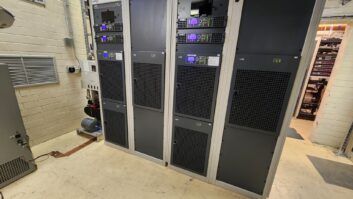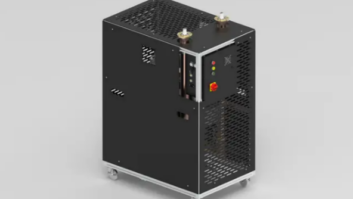
Eric Schecter is DOE of CBS Radio/Phoenix. He’s shown in the KMLE(FM) on-air studio, one of three Class C FMs for which he’s responsible.
Credit: Photo by Jason PawlikOne in a series of occasional articles about radio technology executives and the evolving broadcast engineering profession.
PHOENIX — Eric Schecter was a wide-eyed 11-year-old when he walked into the on-air studio of WABC(AM) in New York City on a glorious Sunday afternoon in 1968 and became hooked on broadcasting.
So indelible is the memory of that radio station tour, which was arranged by a camp counselor, that he remembers the day of the week and who was on the air that day: DJ Roby Yonge. So it goes when you reach a significant turning point of your career path at such an early age.
(Incidentally, Yonge was fired from the station just a year later after reporting on the air that Paul McCartney of the Beatles might be dead, Schecter recalls.)
Schecter, director of engineering with CBS Radio/Phoenix, is responsible for the technical operations of three full-power Class C FMs in the Valley of the Sun.
KMLE(FM), KOOL(FM) and KZON(FM) have studios downtown and transmitter sites about 1,500 feet above the city on South Mountain, a well-known antenna farm in the region.
The 57-year-old Schecter lists his specialties on his LinkedIn profile page as FM transmitter installation, maintenance and repair, HD Radio broadcast technologies and RDS data transmission.
Schecter, a University of Arizona graduate, is responsible for day-to-day engineering for the cluster of three CBS Radio FMs.
“Everything from studio to transmitter is in our department. I also oversee all capital project management and building management.”
Schecter has under him an assistant engineer, Chris Ark, who has been with the stations for approximately two years.
“My department handles all of the regular engineering items, from collating all EAS logs to doing some commercial affidavit stuff for our HD2s,” Schecter said. Tim Pohlman is senior vice president/market manager for CBS Radio/Phoenix.
ENGINEERING, IT EFFORTS
The CBS Radio/Phoenix uses an in-building trouble ticket system to alert the engineering staff of equipment and engineering problems, he said.
“It always seems we have ‘fix’ tasks. We check all backup generators every week. Every day is different really. We might be moving an office one day,” he said, then working next on a nontraditional revenue project.
Schecter, who served as interim IT manager at the cluster for a short time, said the engineering department works closely with IT to manage the stations’ digital products.
The IT director for the cluster, Mike Sforza, had limited radio experience when he joined the stations; Schecter has been training him on the intricacies of radio.
“Our new IT manager takes great care in providing excellent desktop support to the office staff and takes care of critical server maintenance. We are developing a good synergy so that we help each other out as needed in all aspects of station operation,” Schecter said.

Schecter on South Mountain, the transmitter site about 1,500 feet above Phoenix for KMLE(FM), KOOL(FM) and KZON(FM).
Credit: Photo by Chris Ark The engineering department is responsible for maintaining websites and streaming, he said, working closely with the online content network CBS Interactive.
“We work hard to ensure the quality of the streaming product. We stream everything. And everything that leaves the plant is all encoded with [Portable People Meter] encoding for Nielsen rating purposes,” Schecter said. “We capture a lot of live video and audio. We have a live performance studio that we utilize for a lot of content.”
He said IT security is handled primarily by corporate at CBS IT and Security in New York. One CBS Radio strategy is to segregate automation systems, which include Broadcast Electronics AudioVault systems in Phoenix, from office networks.
“We put the automation systems on a different subnet and lock it down. We firewall everything, and we make sure to change all default passwords on any appliances connected to the Internet,” he said.
KOOL and KMLE have HD2 channels, and Schecter is launching one soon for KZON. CBS Radio is committed to HD Radio, Schecter said. He believes the technology holds great promise for the evolving auto dashboard.
“Obviously, the demand for HD Radio is more on the mobile front. We now live in a digitally connected world. I think the Artist Experience is a great branding opportunity,” he said, “and song tagging is important. Anything to make the consumer experience more interactive is good.” CBS was an early backer of iBiquity predecessor, USA Digital Radio Partners and has been a long-time proponent of the technology.
Schecter, who visits the tower sites on South Mountain every two weeks to do routine inspections, said he is meticulous about fine-tuning the HD channels for CBS Radio in Phoenix, maintaining proper alignment to limit the jumps from analog to digital and back that annoy listeners.
“We have all of the routes to get all of the HD data in-house, and then interpreted by the middleware, in this case the Artist Experience, and then to the exporter,” Schecter said.
The Phoenix stations’ studio automation systems feed the middleware programs — such as TRE, PADapult or Jump2Go — that receives PAD data as well as Artist Experience data (including TagStation) from the Internet and inserts it in the HD UDP stream. That is then sent to the transmitter site via an Ethernet subnet link that is isolated from the business and audio LAN subnets, according to Schecter.
CBS Radio/Phoenix locates the exporter and the audio processing at the transmitter site, he explained, and then uses a direct Ethernet connection from the exporter to the exgine card in the exciter.
“Then you don’t have to deal with latency issues or dropped packets. It really simplifies the whole process. The alignment is really perfect. That way you meet the iBiquity specs and ensure a better listening experience for your audience,” Schecter said.
TEMP EXTREMES
There are challenges to maintaining equipment exposed to extreme heat and sun; the average Phoenix July high temperature is 106.
“Keeping all of the air conditioning units working is the top priority. We have seven alone at the transmitter sites. We have a very good preventive maintenance programs. Keeping up with building infrastructure is a challenge, too, since heat takes the toll on roofs,” he said.
South Mountain generally is a bit cooler than the desert floor in Phoenix; however it can experience drastic changes in temperature from day to night, which can create havoc with transmission lines, according to Schecter. “All the expansion and contraction can be tough on the lines. You have to watch your pressurization closely.”

This is an autographed photo of DJ Roby Yonge, whom Schecter met when touring WABC(AM) in New York in 1968. It was his first trip to a radio station. Schecter began his radio career post college on-air at KWFM(FM) in Tucson, Ariz.; he’s spent most of his career in Arizona, working in technical positions for Shamrock, Chancellor, AM/FM, Infinity and now CBS Radio. He also completed a four-year stint in San Diego working for Lincoln Financial at a cluster of radio stations from 2005–09.
Schecter recently was elected to the board of directors of the Society of Broadcast Engineers. He looks back on his technical broadcast career that now spans nearly 40 years and hopes to encourage others to follow suit in getting into the industry.
The SBE has created a committee on mentoring, which Schecter will chair, to explore ways to widen outreach within the radio engineering industry. “Our ranks have thinned. Broadcast engineering is becoming more IT-centric, and radio faces a challenge of recruiting young engineering talent that have the love of a job that requires a desire to serve,” he said.
The next-generation broadcast engineer will have to be excellent at marrying the new IT disciplines with some of the traditional RF skills, he said.
Schecter has trained a number of assistants who have moved on to top engineering jobs at other radio stations; he has a passion for giving back to his profession. “I think that is my calling. To mentor younger people and share this knowledge I have gained.”
Schecter, long active in SBE Chapter 9 in Phoenix, said being mentored was important in his career. He credited the late Elliott Klein, who hired Schecter at KNIX(AM) in Phoenix in the early 1980s, for teaching him about AM directional arrays. Other colleagues who encouraged Schecter’s professional development were industry engineers Bert Goldman, Bill Croghan and Jeff Littlejohn.
As the SBE mentoring committee takes shape, with the help of former SBE President Ralph Hogan, Schecter is focusing on a project for KOOL this winter that entails replacing a pair of Harris FM-25Ks on South Mountain with new solid-state transmitters and HD Radio equipment.
CBS Radio/Phoenix plans to elevate digital power levels on sideband channels from the current –20 dBc to –14 dBc where technically feasible, he said.
“This will be accomplished on KOOL with that new transmitter replacing a space-combined system with a low-level combined strategy. I’ve noted that the increase of 6 dBc results in marked improvement both at home and the mobile environments,” Schecter said.
Schecter lives with his wife, Soosie, a veterinary technologist from Great Britain, in Scottsdale, Ariz. He is a licensed Extra Class Amateur Radio Operator with call sign KC7ES.
“I have a modest station, but I love to chase distant stations,” he said.












